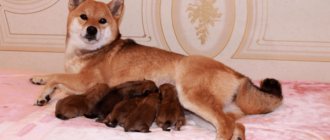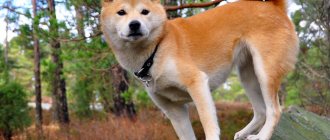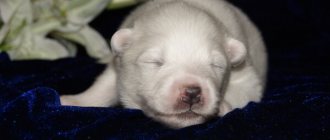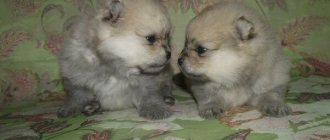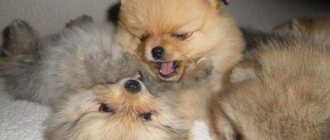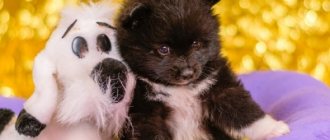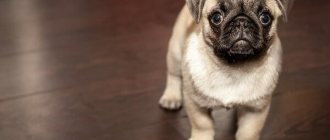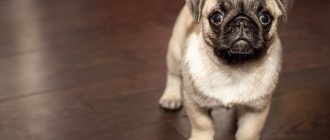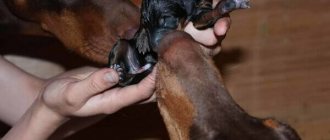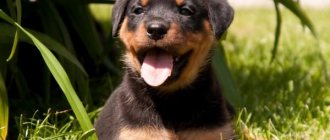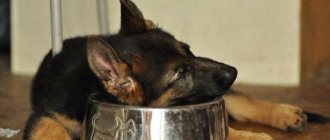Shiba Inu puppies are neat, friendly and very active.
In addition, they are smart, but sometimes they can be stubborn and obstinate.
From a young age, a pet is able to build relationships with all family members, and they will be different with each person.
Shiba Inu puppies are much more active than adult dogs, so they need special nutrition, exercise and discipline.
What do newborns look like in photos?
A newborn Shiba Inu is a small ball of fur that can do almost nothing and is completely dependent on its mother..
The body of a newborn puppy is dense, elastic, but at the same time it is devoid of fat. The mother performs the heating functions for him. In the first two weeks, the puppy cannot see, hear, and cannot defecate on its own.
The Shiba Inu's eyes open 10-15 days after birth..
Most healthy Shiba puppies weigh 400-700 g at birth. The body length of a newborn is 10-14 cm.
Nicknames
Usually called by Japanese names, but you can find European nicknames.
| For boys | For girls | Japanese names | ||
| Nike | Danto | Tracey | Bonnie | Aiki |
| Duncan | Clyde | Yumi | Jinnah | Sensei |
| Fry | Bake | Kira | Utah | Kyoto |
| Dresden | Olympus | Taya | Ibara | Ay |
| Pier | Don | Cleo | Danna | Bo |
| Chio | Teffi | Wilsa | Yumi | Eko |
| Strike | Zeus | Gati | Jacqueline | Kabuki |
How it develops day by day in the first month
| Age (days) | Baby development |
| 1-5 | At this age, the puppy is completely dependent on its mother. All he can do is suck, squeak and crawl around. A newborn puppy lacks vision, hearing and thermoregulation. |
| 6-8 | During this period, the pet is actively gaining weight. By the end of the first week, the dog weighs approximately 2 times more. |
| 9-10 | In the second week of life, the baby not only increases in weight, but also in strength. Now you can easily identify stronger and weaker individuals. |
| 15 | Starting from this period, the puppy's eyes gradually open. He reacts to light, but does not yet know how to navigate in space. The baby begins to develop its own thermoregulation, vision and hearing. Dependence on the mother becomes less. |
| 16-18 | The puppy already sees and hears well. |
| 19-22 | The first teeth are erupting. |
| 23-24 | Interest in solid food appears, the puppy learns to bite and chew. During this period, he begins the first stage of socialization. |
| 25-30 | The puppy is much less dependent on its mother, eats solid food, shows interest in its surroundings, and actively plays with its brothers and sisters. |
Development from 1 to 12 months
The table below shows how the average size of a Shiba Inu changes as the puppy grows.
| Age in months | Size | Weight | Description |
| 1 | 10-14 | 400-600 g | In the first two weeks after birth, the puppy is completely helpless. After the second week of life, the baby can already see and hear. And by the end of the first month, he eats independently and masters the world around him. |
| 2 | 16-18 | 2.3-3 kg | The baby is getting teeth, he is actively growing and socializing. During this period, the puppy is taken away from its mother. |
| 3 | 18-22 | 3-4 kg | Socialization and growth continues. At this age, leaders begin to emerge. |
| 4 | 22-25 | 4.5-5.5 kg | The puppy enters adolescence, baby teeth are replaced by permanent teeth, and the formation of its own immune system occurs. |
| 5-6 | 26-30 | 5.6-8.7 kg | The second stage of socialization, at this age dogs often fight for primacy and leadership. The reason is entering the puberty phase. |
| 7-9 | 27-33 | 9-15 kg | Bitches begin their first heats and growth slows down. The dog does not gain weight so quickly and becomes like an adult dog. |
| 10-12 | 30-35 | 15-25 kg | The end of puberty and character formation. Now she is a young adult dog. |
Description of the breed
The Shiba Inu is a proportionally built dog with a harmonious physique, a strong muscular corset and a willful character .
Standards
According to Nippo, FCI standards, adult dogs should be small in size, males height to withers ranges from 36 to 40 cm, weight varies from 9 to 14 kg, Bitches are slightly smaller, height varies from 32 to 36 cm, weight ranges from 7 to 12 kg. Permissible deviations are plus or minus 1.5 cm in height, 1 - 2 kg in weight. The ratio of length to height at the withers is 10:10.
Head
- The size of the body of the head should be in average proportion to the nose, ears and eyes.
- The distance between the edges of the skull is less than between the ears.
- The eyes are small, deep brown, and have a slight slant when looking to the side.
- The ears are dense, in the shape of a triangle and with a slight slope to the sides; when viewed in profile, the shape visually continues the body.
- The ear cartilage should be dense and covered with hair, the tip should not be sharp and semicircular.
- The nose is straight with a black tip at the end.
- Scissor bite with powerful canines.
Body
- The neck is strong, muscular with a smooth transition into the body.
- The body is dense, massive and can withstand heavy loads and long runs.
- Tucked belly, widely exposed chest, ovoid in circumference.
Important! If the chest is not wide enough, the internal organs may not function properly and the front legs may be placed too close to standard.
Limbs
- Despite its small stature, the dog's paws are quite strong and proportionally elongated in relation to its dense body structure.
- The hind limbs are slightly longer than the front, the features of this structure indicate the running qualities of the breed; the dog moves springily and without constraint.
- The forelimbs are straightened, the shoulder blades are slightly inclined, the elbows are placed close to the body.
- The pads are dense and strong, the claws are dark gray, brown or black.
Tail
- The peculiarity of the breed is its tail; according to the standard, it should be curled into a tight ring with a high fit.
- The fur on the tail is fluffier, longer and less dense. May vary in color towards the darker side.
Wool
The basis of the dog's coat is a fairly long, hard, needle-shaped guard hair. The undercoat is quite short, dense, soft and very fluffy . The length of the fur on different parts of the body is different; on the nose it is shorter, closer to the tail it is longer.
Interesting fact. Due to the special structure of the coat, the Shibu feels quite comfortable in the cold, does not get wet in the rain and is not afraid of the wind.
Colors
According to Nippo and FCI standards, Inu distinguishes three types of color:
- red (most common)
- Sesame (zonal)
- black and tan
The dog must have a whitish pattern on the chest, abdomen, neck, cheeks, inside the ear, on the face, paws and chin. This special color is called “Urajivo”; it is common to all dog breeds of Japanese origin.
Unfortunately, dogs similar to the Shiba Inu with a light, bright red color are considered defective.
Character
Not everyone is suited to a dog with an unusually strong and willful character . Every time the dog doubts your leadership, he will begin to claim it. The dog is not the most active breed; it can live calmly in an apartment in a big city. But still, if you look at its hunting past, the dog would be more suited to an owner with an active lifestyle . Shiba will happily go to the park for a long walk or go on a long hike.
The ancestors of the Shiba Inu are half wild wolves, so instincts predominate . In a hunt, a dog can become so carried away by its goal that even its owner is not a hindrance to it; it will completely stop listening to him until it reaches its goal. During a walk, she tends to get involved with another dog or chase a flock of pigeons, so it is better to keep her on a leash .
The peculiarity of her character is that she needs a sufficient amount of free space , her own territory. In the event of an invasion, they are ready to defend their possessions and will easily drive out the intruder. The Shiba gets along very poorly with other pets ; the dog will always try to dominate other furry household members and demonstrate leadership. Everything that runs, jumps, and flies is prey for him.
Important! It is strictly forbidden to show aggression towards a pet; once punished, you can irrevocably damage the psyche and end up with an unbalanced dog.
The dog requires careful attention to itself; it is quite smart and cunning . The owner must be able to understand the dog. The breed is absolutely not suitable for beginners . Many experienced Inu breeders often turn to dog trainers who specialize in this particular breed. She is distrustful of new faces ; it always takes her time to let another person approach her.
Basic rules of care
How to care for Shiba Inu puppies:
- The dog's place should be protected from cold and drafts.
- For the first few weeks, the pet should be in a calm environment and have contact only with family members.
- At the initial stage, the dog is fed the same products as the breeder, and only after 3 months of age can the diet be changed.
- You need to walk your young pet 3 times a day. In the morning - approximately at 6-76 o'clock, at lunch - at 13-14 o'clock and in the evening - at 19-20 o'clock. The duration of each walk is 30-40 minutes.
- Brush your dog daily, this will keep its coat smooth and silky and its skin healthy.
- After 6 months of age, the dog can be bathed no more than once every 2-3 months.
- The puppy's eyes and ears should be examined daily for discharge and dirt.
- About once a week, the pet’s ears are cleaned with a cotton swab or disk, and a special lotion is also used.
- If the dog's eyes are clean, then they do not need treatment.
- The pet's diet must be selected in such a way as to provide it with the required amount of nutrients.
- It is highly advisable to brush your dog’s teeth once a week and regularly examine them for the appearance of tartar. If it appears, you should contact your canine dentist.
- Once every 3 months, the dog must be given anthelmintic drugs.
- As early as possible (at about 2-3 months), you need to accustom your dog to trimming its nails.
- Be sure to take your dog to the veterinarian every six months.
Owner reviews
Quiz_Fyl
Before Toya we got a Shiba Inu! Boy! Lovely! The dog was bought at 3 months from the AstraVegas kennel. Everyone also advised us to take a girl, since females are affectionate and more flexible. But when we saw this red torpedo rushing across the lawn, loudly bursting into playful barking... we melted! What about children? He accepted them as his own and began to play. Just an oil painting of “happy childhood.” Patient? Oh yeah! The children washed their floors, wrapped them in a blanket, dressed them in caps!.. Never said a rude word to them in response.
I QUOTE A PREVIOUS REVIEW: “He treats all people well, without aggression. He lets strangers pet him without pleasure. Yes, yes, many people, especially children, want to pet him, such a cutie. Sometimes they ask to take a photo with him.”
Yes, I’ll add on my own behalf that ours is an excellent hunter (he once caught a duck in the park), an excellent guard! They took a training and obedience course. I have never run away before or since, but we are led on a leash, since in our city it is forbidden to have no leash. Ours loves to ride bikes and cars. Loves to travel and train!
Sibas live a long time, on average 20-25 years, ours is already 7. The toy is still the same. Children use it as an antidepressant. He himself conducts peso-cat therapy to all family members!
He is very clean, when we walk on the street he will go around every puddle, only sometimes he camouflages himself in horse manure... At home he constantly licks himself like a cat. The fur does not smell like other dogs. Sheds little.
A kind, smart dog and an eternal puppy with a cute face, “SMILE DOG”!
natalivv1
Advantages:
She will teach you to love
Flaws:
Seasonal molt
I bought this dog 3 years ago, every day I love my girl Yokki more and more) This is a very mobile and active dog, she is always in the field of attention, not a single event in the house happens without her, she is everywhere. She has inexhaustible energy and if you do not have the opportunity to walk with her a lot, then do not torture the animal. This breed is very smart, willful, active, cunning and jealous. Can't stand it if you love someone more than her. She has a wonderful appearance - the strong constitution of a full-fledged dog with her very small size, only 8 kilograms, with good good health. Slanted eyes and a sharp nose - the appearance of a fox. A gentle and beautiful creation.
Aladushka008
If you are planning to buy a Shiba Inu dog, be prepared for constant questions from passers-by about what breed it is)
A beautiful, playful, very sweet and affectionate dog. He likes to misbehave, but this goes away with age. She remains alone at home calmly, it is enough to lay out a sufficient number of toys and remove everything that can be chewed) She waits for us lying on her bed, sometimes without even touching the toys (she is very bored, but does not bark or howl, which is a very big plus).
He understands well what is possible and what is not. The most important thing is not to allow him to chew furniture and things from puppyhood, then there will be no problems in the future (in half a year we only had one pair of shoes damaged, she chewed them on May 9, when we were away from home for a long time).
The dog loves to lie down and run wild) Be prepared for the fact that this breed needs a lot of attention and games, otherwise you cannot avoid making crazy circles throughout the apartment.
Gets along well with other dogs, with children and in general with all passers-by).
I advise you to feed only super premium food - Monge food is best suited for this breed - the composition has an ideal amount of protein (up to 30%, this breed does not digest protein well) and in general Italian quality will help maintain the dog’s health.
Miniature sizes allow you to have a dog in small apartments. Ideal for those who don't like tiny dog breeds, but whose apartment size doesn't allow for a large breed.
I am very glad that I bought this particular breed, it is truly a wonderful creature)
Ksuha boss
Advantages:
For me in everything
Flaws:
Shedding
Hello to all lovers of shaggy friends!!! We purchased this miracle two years ago, we thought for a very long time about the breed, the size, well, about everything. We arrived at the nursery, spent a long time choosing, and found this beauty. He was sitting so small, alone in a cage. As they explained to us, it was a culling (one tooth was missing), that is, it is not suitable for exhibitions and other things. Well, we just needed a dog, and with such kind eyes, this little face!!! In general, we couldn’t resist and bought it. The price was cheaper than the others, due to the fact that the rejection cost us 50,000 thousand rubles. Well, in general, this beauty has been living with us for a long time, we don’t regret one bit that we chose it! Smart, affectionate, funny. Have you ever heard about a smiling dog, this is about him, a smile from ear to ear. He also loves to talk and makes such interesting sounds. The only problem we have is food! Allergic to everything! Whatever he doesn’t eat, he immediately itches, so he eats only dry food. In general, if you decide to buy yourself such a friend, I recommend it, you won’t regret it! Good luck to you, love animals, and they will repay you in kind.
Video
How to toilet train?
The first thing to start with is daily walks . As already mentioned, you need to walk your Shiba Inu puppy 3 times a day for 3-40 minutes.
During this time, the baby will definitely want to go to the toilet. When this happens, focus your attention on it, praise it, play with it, or give your baby a treat.
At the same time, when the dog is in the apartment, observe his behavior . How does he behave when he wants to go to the toilet? He may be getting restless, looking for a seat or sitting down. As soon as you notice such signs, immediately take your dog outside.
A proper feeding schedule can also help with toilet training . If the dog eats at the same time, then it will also defecate. In this case, you will easily notice the characteristic signs and be able to react in time.
Métis
Common crosses with the following breeds:
- Corgi. Small stature, like a corgi, with characteristic short legs. The color and expressiveness of facial expressions remain from the Shiba-ken.
- Spitz. Short stature is also inherited and becomes more like a Spitz.
- Pug. The muzzle stretches out a little, but otherwise the signs remain the same as those of a pug.
- Husky. The color changes, the eye color becomes dark. Heterochromia may occur.
What to feed for the first 3 months?
In the first three months, the puppy's digestive system goes through a period of formation . At this time, it is better to keep the baby on natural food. In addition, meals should be fractional. During this period, the dog is fed 5-6 times a day in small portions.
The optimal daily amount of food for a Shiba Inu puppy should be 5% of its weight.
Mating
The Japanese breed of Shiba Inu dogs is rare in Russia, so finding a suitable partner for mating is quite difficult. Only 1.5-year-old sexually mature and fully formed animals are capable of reproduction.
The best mating days for dogs are between 10 and 15 after the start of their heat. The animals are first taken for a walk, then the bitch is taken to the dog.
Dogs are often bred for free - in rare cases, human intervention is required. After 24-48 hours, a control mating is carried out to increase the likelihood of conception. Shiba Inu pregnancy lasts 58-66 days. 4-6 puppies are born in a litter.
Dry or natural food, which is better?
Both ways of eating have their pros and cons.
Dry food already contains all the necessary substances . In addition, it is much cheaper and easier to feed your dog with it. The owner does not need to select food and cook every day. The main disadvantage of dry food is preservatives and other harmful additives.
Natural nutrition is more natural. Meat, fish, and vegetables give the dog everything he needs for a healthy life and does not contain harmful components .
Feeding
Food familiar to humans can cause allergies in a Shiba, since this breed originated on islands where fish is considered the standard diet. In this case, the easiest way would be to choose ready-made dry food, completely balanced and containing one type of protein.
If you are a person who prefers natural feeding, you should consider some features. The main product is fish: tuna or salmon. From time to time, fish can be replaced with lamb or duck.
Both fish and meat must undergo heat treatment before consumption. This will reduce the risk of an allergic reaction.
Rice porridge is good for animals. It is also recommended to add vegetables, a source of vitamins and fiber, and fermented milk products to the menu.
Fermented milk products must be low-fat. They should be given to a pet only if they do not harm the animal’s digestion.
If there is a need to switch your pet to another food, it should be taken into account that this must be done gradually.
If a food allergy or intolerance occurs, you should completely switch to special veterinary food.
It should be noted that dogs are strictly prohibited from giving foods such as smoked meats, baked goods, sweets and chocolate.
How to feed correctly and how often?
The number of meals depends on the age of the puppy . The older he is, the less often he is fed. So a 3-4 month old baby is fed 5 times a day every 4 hours.
At 4-6 months, the pet is transferred to 4 meals a day at intervals of 4-5 hours . After 6 months of age, the dog eats 3 times a day at intervals of 6 hours. When your pet turns 10 months old, he can be switched to 2 meals a day.
IMPORTANT!
Meat products should make up at least 40% of the total food.
Another 30% should be fermented milk products, the remaining 30% should be cereals, vegetables, fruits, eggs and offal.
Menu for the week
Monday:
- Breakfast - kefir or cottage cheese.
- Lunch – oatmeal with a piece of boiled veal.
- Dinner - boiled fish with stewed cabbage.
Tuesday:
- Breakfast - yogurt or curdled milk.
- Lunch – buckwheat porridge with liver.
- Dinner - stewed beets with chicken.
Wednesday:
- Breakfast – boiled egg with low-fat sour cream.
- Lunch – scalded heart with rice porridge.
- Dinner – stewed zucchini or pumpkin.
Thursday:
- Breakfast – boiled egg and kefir.
- Lunch – boiled chicken with rice.
- Dinner – stewed cabbage with a piece of boiled fish.
Friday:
- Breakfast – stewed carrots, low-fat kefir.
- Lunch – buckwheat porridge and light.
- Dinner – fresh cucumber, a piece of chicken.
Saturday:
- Breakfast - yogurt or curdled milk.
- Lunch – buckwheat porridge with veal.
- Dinner – boiled egg with oatmeal.
Sunday:
- Breakfast – yogurt or kefir.
- Lunch – rice porridge with liver.
- Dinner - fresh cabbage and low-fat broth.
Vaccination schedule and which ones should be done
Shiba Inu cheek vaccination schedule:
| Puppy age in months. | Vaccine |
| 2 | Complex vaccine against plague, parainfluenza, leptospirosis, hepatitis, enteritis. |
| 4-6 (after permanent teeth grow in) | Revaccination against the same diseases is carried out. |
| 9-12 | The dog is vaccinated against rabies, plague, enteritis, influenza and hepatitis. |
After one year of age, the pet must be vaccinated annually, once a year, throughout its life.
Origin story
Shiba Inu are indigenous Japanese hunting dogs. The history of the breed goes back centuries. Animals have existed side by side with people for many centuries and helped them hunt a wide variety of wild animals, from birds to wild boars.
Are you looking for a Shiba Inu? Yes 40.91% Still thinking 13.64% Already there! 45.45%
At the turn of the 20th century, the Shiba Inu was on the verge of extinction due to excess blood from English hunting dogs. But thanks to the work of local enthusiasts, the breed was preserved. As a result of the work of Japanese breeders, the first official standard was approved in the 1930s. Three years later, the Shiba Inu was recognized as a national treasure.
The literal translation of “Shiba Inu” is “little dog.” In their homeland, animals are usually called sibaken.
Which dry food to choose?
For a Shiba Inu puppy, premium or super premium food is suitable, designed specifically for puppies of small and medium breeds.
Shiba Inu should not be given food containing soy, wheat or bone meal.
Food is perfect for this breed:
- "About the Plan."
- "Akana".
- Royal Canin.
How to bathe? Cleaning teeth, ears, trimming nails, grooming
Basic rules for swimming:
- It is not advisable to bathe your Shiba Inu baby before the age of 6 months.
- Starting from six months, this should be done once every 2-3 months using special shampoos and conditioners.
- The temperature for swimming should be 38-40 degrees.
- A diaper or a special mat is placed at the bottom of the bath to prevent the dog's paws from slipping.
- When bathing for the first time, there should not be a lot of water in the bath so that the dog does not get scared.
- After the procedure, the pet is wrapped in a soft towel and gently blotted, and then dried with a hairdryer.
The puppy's ears should be cleaned once a week, using a cotton pad or swab dipped in a special lotion . The auricle is wiped both from the outside and from the inside, treating the surface first with a damp and then a dry swab.
Teeth brushing is carried out once a week using a special paste and brush for dogs.
The pet's nails are trimmed as they grow . For the procedure, a special bone cutter is used, which allows the procedure to be carried out painlessly and without injuring the pet. After which the claws are treated with a nail file to prevent cracking.
You need to brush your Shiba Inu puppy daily using a special massage brush . The procedure stimulates blood circulation and promotes healthy skin and coat.
Shiba Inu character
Shiba is a difficult and often incomprehensible dog for Europeans. The saying “The East is a delicate matter” perfectly suits the character of the Shiba Inu. From the inhabitants of her homeland she adopted calmness, fearlessness, stubbornness and love of freedom. And feelings are often hidden behind a mask of indifference.
Shiba-ken loves his owner infinitely and cannot stand separation from him. But will not show affection like other dogs. Forget about jumping, face licking, tail wagging, joyful barking and unquestioning submission. Outwardly, the Shiba is calm, it can ignore the owner and disobey him. Everyday expression of feelings comes down to the fact that the pet follows the owner everywhere and participates in household chores. But as soon as something threatens family members, the little red fox turns into the most fearless and selfless defender who will stand up for “their own” to the death.
When getting a puppy, prepare yourself for the fact that you are taking on a full-fledged family member and an equal partner. You will have to take into account the dog’s opinion and worldview in the same way as you do with people. Be prepared to compromise, but, naturally, not at the expense of obedience.
Interesting! A characteristic feature of the Shiba Inu is a tendency to contemplate the world. Dogs can spend hours admiring the sunset, the flow of a river or the flight of birds. And on every walk, at least for 15 minutes, they will freeze, enjoying the landscapes of nature.
Staring at the leaves
Shiba Inu is a terrible owner. He can't stand it when people touch his things and food. For this reason, it is better not to get a puppy for families with children under 10 years old. Children do not yet have the concept of personal boundaries, which can lead to conflicts.
Also, the Shiba Inu does not get along well with other pets. Perceives rodents and birds as prey. Often cats also suffer from his teeth. But if he grew up with a kitten, the establishment of a “bad world” is possible. He does not like other dogs, especially males, and often fights with them. And on walks he prefers not to play with his fellow tribesmen, but to watch their fuss from the sidelines.
With cat
The Shiba Inu is wary of strangers. Rarely shows aggression, but avoids strangers. If someone wants to pet the pet, he will shy away. In extreme cases, it will growl or click its teeth in warning.
By nature, Shiba Inus are more reminiscent of cats than dogs. Dogs are clean, independent, graceful, and love to climb on surfaces or climb into cabinets. They also meow funny when they stretch.
By the way, Shibas hardly bark. But they make a lot of different sounds. In addition to meowing, their arsenal includes croaking, squealing, screaming, grunting and creaking.
How to train correctly and what commands to teach?
The main aspect of raising a Shiba Inu is the inadmissibility of frequent rewards with treats, otherwise the dog will begin to cheat and beg for treats..
The second important aspect is the inadmissibility of shouting and corporal punishment. The dog must understand the intonation of the owner’s voice and gaze.
First of all, the puppy should be accustomed to its name, and then start giving commands.
The first command a dog should know is “place” . To teach this to your puppy, take him to his place every time he wants to sleep. At the same time, say the command loudly several times.
The next important command is “fu” . Whenever the puppy does something inappropriate, say the command sternly and loudly and distract the puppy with other actions.
The “come to me” command is also considered one of the main ones . Start learning at home. Call the baby by name and say loudly: “Come to me!”, while tapping your hand on your thigh.
When your pet follows the instructions, praise him or give him a treat. A little later, training continues on the street.
How to choose?
Advice from experienced dog breeders:
- Never buy a puppy at a poultry market; find a specialist who breeds dogs of this particular breed.
- You should not buy the first puppy you come across; examine several individuals before making a decision.
- Never agree to meet with a breeder on neutral territory; examine the babies directly at the kennel, so you can see the conditions in which the dogs are kept.
- Ask the seller to show the baby's mother and father. If the father is absent, a professional breeder always has his photo.
- When examining parents, you should pay attention to their breed characteristics.
- Be sure to ask the breeder to show the parents' documents, as well as the veterinary passport and puppy card of the chosen pet.
- Clean, well-groomed and well-fed dogs in the kennel are a good sign.
- Examine the puppy itself. A healthy pet has smooth shiny fur, clear gases (no discharge), clean skin and mucous membranes. A healthy puppy is inquisitive and active without being nervous.
